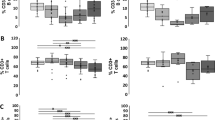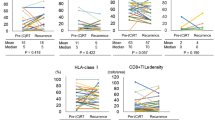Abstract
Purpose
Adenoid cystic carcinoma (ACC) of the head and neck is a rare and highly malignant tumor, characterized by perineural growth and early distant metastases. The composition of immune cells in the peripheral blood and the tumor microenvironment is critical to tumor growth and control. However, little is known about the frequency and function of the relevant immune cell subsets in this entity.
Methods
In ACC patients (n = 11) and matched healthy donors (n = 11), the frequency of peripheral blood T and B cells was measured by flow cytometry at different treatment stages of disease (24 samples). Cells were further characterized by their expression of CCR7, PD-1, CD39 and CD73. Tumor-infiltrating lymphocytes (TIL) were analyzed by immunohistochemistry for ten patients and for three patients by flow cytometry.
Results
CD4+ T cells had significantly lower frequency after radiotherapy (RT). All other cell frequencies, including Treg, were stable through course of the disease. In B cells, CD73 was reduced after RT. CCR7 expression on T and B cells in patients with relapse/metastases (R/M) differed significantly from patients with active disease. PD-1 remained stable. Treg were more present in TIL compared to peripheral blood.
Conclusion
Composition of lymphocyte subgroups behaves similar to squamous cell carcinoma in the head and neck, except for Treg, which remained stable. Nevertheless, the CD4+/Treg ratio was lower after RT, which could stand for an immunosuppressive effect in these patients. Therefore, it could be beneficial treating ACC with combined RT and immunomodulatory drugs.





Similar content being viewed by others
Abbreviations
- ACC:
-
Adenoid cystic carcinoma
- TIL:
-
Tumor-infiltrating lymphocytes
- RT:
-
Radiotherapy
- R/M:
-
Relapse/metastases
- CAP:
-
Cisplatin, doxorubicin, and cyclophosphamide
- ADO:
-
Adenosine
- PBMC:
-
Peripheral blood mononuclear cells
- NC:
-
Normal controls
- AD:
-
Active disease
- mAbs:
-
Monoclonal antibodies
- FSC:
-
Forward scatter
- SSC:
-
Side scatter
- MFI:
-
Mean fluorescence intensity
- SRG:
-
Surgery
References
Chae YK, Chung SY, Davis AA et al (2015) Adenoid cystic carcinoma: current therapy and potential therapeutic advances based on genomic profiling. Oncotarget 6:37117–37134
Lloyd S, Yu JB, Wilson LD, Decker RH (2011) Determinants and patterns of survival in adenoid cystic carcinoma of the head and neck, including an analysis of adjuvant radiation therapy. Am J Clin Oncol Cancer Clin Trials 34:76–81
Thompson LDR, Penner C, Ho NJ et al (2014) Sinonasal tract and nasopharyngeal adenoid cystic carcinoma: a clinicopathologic and immunophenotypic study of 86 cases. Head Neck Pathol 8:88–109
Coca-Pelaz A, Rodrigo JP, Bradley PJ et al (2015) Adenoid cystic carcinoma of the head and neck—an update. Oral Oncol 51:652–661
Rettig EM, Talbot CC, Sausen M et al (2016) Whole-genome sequencing of salivary gland adenoid cystic carcinoma. Cancer Prev Res (Phila) 9:265–274
Chang H, Kim JS, Choi YJ et al (2017) Overexpression of PD-L2 is associated with shorter relapse-free survival in patients with malignant salivary gland tumors. Onco Targets Ther 10:2983–2992
Sato E, Olson SH, Ahn J et al (2005) Intraepithelial CD8 + tumor-infiltrating lymphocytes and a high CD8+/regulatory T cell ratio are associated with favorable prognosis in ovarian cancer. Proc Natl Acad Sci USA 102:18538–18543
Lai C, August S, Albibas A et al (2016) OX40 + regulatory T cells in cutaneous squamous cell carcinoma suppress effector T-cell responses and associate with metastatic potential. Clin Cancer Res 22:4236–4248
Clarke SL, Betts GJ, Plant A et al (2006) CD4 + CD25 + FOXP3 + regulatory T cells suppress anti-tumor immune responses in patients with colorectal cancer. PLoS One 1:e129
Coronella JA, Telleman P, Kingsbury GA et al (2001) Evidence for an antigen-driven humoral immune response in medullary ductal breast cancer. Cancer Res 61:7889–7899
Milne K, Kobel M, Kalloger SE et al (2009) Systematic analysis of immune infiltrates in high-grade serous ovarian cancer reveals CD20, FoxP3 and TIA-1 as positive prognostic factors. PLoS One 4:e6412
Riemann D, Wenzel K, Schulz T et al (1997) Phenotypic analysis of T lymphocytes isolated from non-small-cell lung cancer. Int Arch Allergy Immunol 114:38–45
Distel LV, Fickenscher R, Dietel K et al (2009) Tumour infiltrating lymphocytes in squamous cell carcinoma of the oro- and hypopharynx: prognostic impact may depend on type of treatment and stage of disease. Oral Oncol 45:e167–e174
Czystowska M, Gooding W, Szczepanski MJ et al (2013) The immune signature of CD8(+)CCR7(+) T cells in the peripheral circulation associates with disease recurrence in patients with HNSCC. Clin Cancer Res 19:889–899
Li J, Jie H-B, Lei Y et al (2015) PD-1/SHP-2 inhibits Tc1/Th1 phenotypic responses and the activation of T cells in the tumor microenvironment. Cancer Res 75:508–518
Lechner A, Schlößer H, Rothschild SI et al (2017) Characterization of tumor-associated T-lymphocyte subsets and immune checkpoint molecules in head and neck squamous cell carcinoma. Oncotarget 8:44418–44433
Ferris RL, Blumenschein G Jr, Fayette J et al (2016) Nivolumab for recurrent squamous-cell carcinoma of the head and neck. N Engl J Med 375:1856–1867
Ohta A, Gorelik E, Prasad SJ et al (2006) A2A adenosine receptor protects tumors from antitumor T cells. Proc Natl Acad Sci USA 103:13132–13137
Blay J, White TD, Hoskin DW (1997) The extracellular fluid of solid carcinomas contains immunosuppressive concentrations of adenosine. Cancer Res 57:2602–2605
Saze Z, Schuler PJ, Hong CS et al (2013) Adenosine production by human B cells and B cell-mediated suppression of activated T cells. Blood 122:9–18
Schuler PJ, Schilling B, Harasymczuk M et al (2012) Phenotypic and functional characteristics of CD4 + CD39 + FOXP3 + and CD4 + CD39 + FOXP3neg T-cell subsets in cancer patients. Eur J Immunol 42:1876–1885
Schuler PJ, Harasymczuk M, Schilling B et al (2011) Separation of human CD4 + CD39 + T cells by magnetic beads reveals two phenotypically and functionally different subsets. J Immunol Methods 369:59–68
Schuler PJ, Macatangay BJ, Saze Z et al (2013) CD4(+)CD73(+) T cells are associated with lower T-cell activation and C reactive protein levels and are depleted in HIV-1 infection regardless of viral suppression. Aids 27:1545–1555
Ziebart A, Huber U, Jeske S et al (2018) The influence of chemotherapy on adenosine-producing B cells in patients with head and neck squamous cell carcinoma. Oncotarget 9:5834–5847
Moncrieffe H, Nistala K, Kamhieh Y et al (2010) High expression of the ectonucleotidase CD39 on T cells from the inflamed site identifies two distinct populations, one regulatory and one memory T cell population. J Immunol 185:134–143
Wagner D-C, Roth W (2018) Prognostic significance of immune cell infiltrates in tumor pathology. Pathologe 39:532–538
Sridharan V, Gjini E, Liao X et al (2016) Immune profiling of adenoid cystic carcinoma: PD-L2 expression and associations with tumor-infiltrating lymphocytes. Cancer Immunol Res 4:679–687
Schuler PJ, Harasymczuk M, Schilling B et al (2013) Effects of adjuvant chemoradiotherapy on the frequency and function of regulatory T cells in patients with head and neck cancer. Clin Cancer Res 19:6585–6596
Ebert LM, Schaerli P, Moser B (2005) Chemokine-mediated control of T cell traffic in lymphoid and peripheral tissues. Mol Immunol 42:799–809
Hanke T, Melling N, Simon R et al (2015) High intratumoral FOXP3(+) T regulatory cell (Tregs) density is an independent good prognosticator in nodal negative colorectal cancer. Int J Clin Exp Pathol 8:8227–8235
Spranger S (2016) Mechanisms of tumor escape in the context of the T-cell-inflamed and the non-T-cell-inflamed tumor microenvironment. Int Immunol 28:383–391
Acknowledgements
We thank Katja Hasch, Gabriela Cudek and Monika Jerg for their support in performing the experiments.
Funding
This study was funded by German Research Foundation (DFG) Grant # SCHU 2536/3 and the International Graduate School in Molecular Medicine Ulm.
Author information
Authors and Affiliations
Contributions
SSJ, UH and SEW performed experiments; SSJ and SEW prepared figures; JV and JD provided patient samples; SSJ, PJS and JD designed research and wrote the paper; MNT, CB, and TKH edited the paper.
Corresponding author
Ethics declarations
Conflict of interest
There are no potential conflicts of interest to disclose. The research was supported by the German Research Foundation (DFG) Grant # SCHU 2536/3 (PJS) and by the International Graduate School in Molecular Medicine Ulm (SSJ).
Ethical approval
This article does not contain any studies with animals performed by any of the authors. All procedures performed in studies involving human participants were in accordance with the ethical standards approved by the local ethical committee (#255/14).
Informed consent
Informed consent was obtained from all individual participants included in the study.
Additional information
Publisher’s Note
Springer Nature remains neutral with regard to jurisdictional claims in published maps and institutional affiliations.
Electronic supplementary material
Below is the link to the electronic supplementary material.
Rights and permissions
About this article
Cite this article
Jeske, S.S., Weissinger, S.E., Veit, J.A. et al. Treatment-induced changes of lymphocyte subsets in patients with adenoid cystic carcinoma of the head and neck. Eur Arch Otorhinolaryngol 276, 1465–1473 (2019). https://doi.org/10.1007/s00405-019-05363-2
Received:
Accepted:
Published:
Issue Date:
DOI: https://doi.org/10.1007/s00405-019-05363-2




